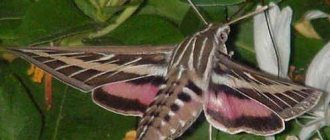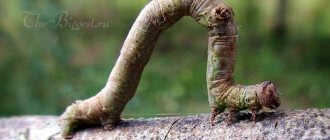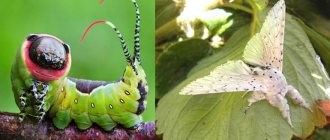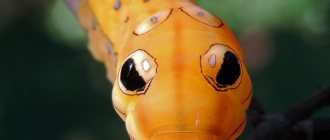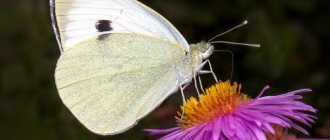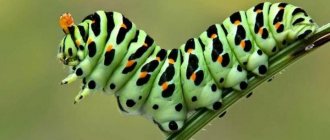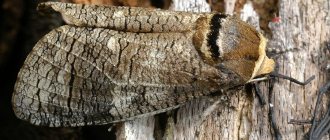We all know firsthand that nature creates masterpieces that at first glance seem completely unusual and even partly cosmic. There are more than enough examples of this among representatives of the world's flora and fauna. In particular, toothed pato fish, proboscis monkeys, water deer with fangs, hairless cats, anteaters with huge trunks, California condors (birds that are impossible to look at without tears), drop fish, reminiscent of characters from a science fiction film with horror elements. The list of natural phenomena is endless.
Incredible species of caterpillars that exist side by side with humans
Today I would like to talk about an insect larva, which subsequently turns into a beautiful creature - a butterfly, at least this is written about in all the encyclopedias about wildlife and the world around us. So, we will talk about caterpillars with horns and their features, which, judging by the name, should not be so few. Looking ahead, I would like to note that such caterpillars are characteristic of many species and they even pose a certain danger to smaller insects, and some to humans. But be that as it may, such representatives of the flora cause only delight in those who look at them, because they are incredibly beautiful and divinely beautiful.
Wine Hawkmoth (Deilephila elpenor)
The caterpillar was found eating grape leaves. She was fat, elastic and green, with a horn and four false eyes in the front.
Friends! This is not just an advertisement, but my, the author of this site, personal request. Please join the ZooBot group on VK. This is pleasant for me and useful for you: there will be a lot there that will not end up on the site in the form of articles.
She behaved actively and did not refuse food in captivity. I also didn’t mind being photographed in different poses. Click on the pictures - they have a lot of details!
But a couple of days later, she disappeared from sight. Carefully turning over the leaves piled on the bottom of the aquarium, I discovered a certain conglomerate: the leaves were clearly glued together. In the depths of the shelter, the strangely modified body of a caterpillar, covered with mucus, lay motionless.
After a day or two, I decided to see what happened in the house of leaves. As soon as I started raking them, I felt something twitch energetically inside. The leaves were glued together perfectly, but what can one poor caterpillar oppose to the destructive power of the human mind?
I don’t think it will be a revelation to anyone that there was a pupa .
The front part of the pupa is completely rigid, the rear part consists of three movably connected segments and ends with a horn. When a doll is nervous, it can beat intensely, frightening the offender and jumping from place to place:
Here's what struck me most. Next to the pupa in the leaves lay the blackened and dried head and front part of the body of a former caterpillar with six horny legs. I never thought about the fact that when a caterpillar turns into a chrysalis, it throws off its head! (“And what does she think with???” - this begs an idiotic question, from which, however, another follows: “Do caterpillars think in principle?”)
The idea for the demotivator is born by itself: “Don’t be a larva! Don't lose your head!
Now all that remains is to put the pupa in a secluded, cool place, and perhaps in the spring I will be able to watch the most exciting stage of the transformation: the birth of a butterfly.
Added six months later: it was possible to observe the birth of a butterfly, although a little earlier than expected. For details and photos, click on the picture:
The medium wine hawk moth is the one that hatched in me six months later. Details.
And now the second story, tragic...
An inhabitant of Russian latitudes, who is often mistaken for an alien
Of course, at the very beginning I would like to talk about those types of large green caterpillars with horns that live in our country. The most common larva of the hawk moth and all its subspecies. For example, linden hawk moth. Its larva is a fairly long caterpillar. Sometimes it reaches 10 cm in length. Its color, unlike other caterpillars with horns, is quite calm and not particularly attractive. Most often, this insect is light beige or light brown in color with a white abdomen, on which there are horny growths, which are nothing more than the rudiments of the insect’s legs. They are quite hard and tenacious to the touch; thanks to these properties, the caterpillar can easily move along tree trunks. In rare cases, linden hawk moth larvae can be bright green or black with brown speckles. No matter what color the caterpillars are, they always have a sharp, hard spike on their tail, which many take for a horn, confusing the insect’s head with its tail.
What do hawk moths look like?
Hawk moth is a moth, that is, a night butterfly. Therefore, it has characteristic features:
- Large body.
- The wings are thin, with the lower ones being significantly shorter than the upper ones.
- The antennae are smooth, without thickening.
- The pattern on the body is similar to the texture of tree bark.
During the flight, the butterfly flaps its wings very quickly, resulting in the impression that it is a tiny bird. The length of the body reaches 11 centimeters, and the wingspan is 3-17 cm. The weight of the moth is 2-6 grams, while the female can weigh up to 8 grams.
Butterflies feed on nectar
The length of the antennae may vary. They have a rod-like structure, the apex can be pointed or slightly curved. The mouthparts are long, which allows them to collect nectar without sitting on the flower.
It can reach 25 centimeters in length. In some types the proboscis is underdeveloped. Others have additional palps on the lips. The insect's eyes have a complex structure, are round in shape, and covered with tufts. The eyes of the hawk moth are capable of distinguishing ultraviolet spectra.
The body of the butterfly is long, slightly narrowed towards the abdomen. As a rule, it is densely covered with hairs, which at the end form a “braid” or brush. The pectoral muscles are especially developed, which allows them to quickly flap their wings, developing enormous speed. Sometimes it reaches 54 km/h. while the wings rise up to 3120 times per minute.
Butterflies have ways of covering long distances by migrating between continents.
Hawk moths are able to perfectly combine protective and repellent colors. The upper wings are similar to the bark, so it is difficult to find insects on trees. The lower ones are very bright and catchy. Therefore, when danger appears, the butterfly throws out its lower wings, thereby scaring away the enemy.
Hawk Moth is good at camouflage
Hawkmoths have long legs, matching the color of their wings. There are a pair of spurs on the shins; similar spines are also found on the paws. The moth has a total of 6 legs.
Ocellated Hawkmoth
Speaking about butterflies that hatch from the pupa of the hawkmoth caterpillar, it should be noted that all representatives of the family of these unusual insects are considered quite rare, and many of them are listed in the Red Book. Their extermination can have serious consequences and is punishable by law. For example, the hawk moth. By the way, its larva is one of the most unusual: green with white stripes, located symmetrically relative to each other. This is a large green caterpillar with a horn on its tail that is pale blue in color. Speaking about the larva of the ocellated hawk moth, it must be said that the thorn of these insects is not at all for beauty, but for protection from annoying small brothers: ants and small bugs. It is something like a sting, which, like wasps, contains poison (acid) that affects the enemy. For humans, the “weapon” of the hawkmoth caterpillar does not pose any danger.
What types of hawk moths are there?
There is a huge variety of moths in this group. It will be very convenient to consider the hawk moth family in the table.
| Species names | Description of the wings |
| Hawk hawk | The upper ones are red in color with brown spots. There are bright blue “eyes” on the lower wings. |
| Hawkmoth is blind | On the lower tier there are bright spots imitating the eyes of animals. |
| Lesser oleander hawkmoth | It has green upper wings with a dark spot. The lower wings are bright orange with a pronounced border. |
| Brazhnik Tatarinov | The green upper wings are complemented by red-gray lower wings. |
| Euphorbia hawk moth | Green upper wings with a light stripe in the center and spots. The lower ones are black with a pink border. |
| Ademarius of Darius | The wings of the upper tier are discreet, helping to hide. The lower ones are pink with black trim. |
| Hawkmoth common tongue | Large wings are gray with stripes. Small ones are bright orange. |
| Lilac Hawkmoth | The upper ones are brown, and the lower ones are pinkish with clearly defined black transverse stripes. |
| Hawkmoth anthea | This butterfly has yellow wings with transparent “windows”. The body, or rather its sides, is also covered with yellow hairs. |
| Hawkmoth Megaera | Large wings are green, small wings are yellow. |
| Aspen Hawkmoth | Both large and small wings are lilac in color. |
| Pine Hawkmoth | Large wings are gray and inconspicuous. Small ones of the same color. At the same time, there are stripes on the body that form a clear square. |
| Pink Hawkmoth | The body and wings of the insect are yellow-pink, but the antennae are pure white. |
Dead Head
Another prominent representative of hawk moths living in Russia, which is worth mentioning separately, is the dead (Adam's) head butterfly. Her caterpillar is incredibly beautiful. It is large, bright green, monochromatic or with variegated spots scattered over the body. The spike on her tail is the same color as her coat. But a coal-black butterfly with bright brown spots hatches from such a miracle. In general, this species resembles in its color the king of the savannah - the leopard. The death's head hawk moth is, without a doubt, more beautiful than the kinglet and several times larger. Now, having encountered any of the larvae described above in your garden, the attentive reader should not have a question about what the caterpillar with a horn on its tail is called.
Hawk Moth Life Cycle
During reproduction, it goes through the following stages:
- 5-10 days in egg shape.
- 17-35 days in the larval stage.
- From 10 days to 3 years in the form of a pupa.
- 2-3 weeks in the adult stage.
Under good conditions, three generations appear per year. Butterflies find partners due to the ability of the latter to secrete pheromones. Females also change in appearance: their bodies thicken, and in flight they make characteristic sounds.
Mating occurs at positive temperatures. The ocellated hawk moth is the least demanding of it. Together with the seminal fluid, the female butterfly also receives protein for nutrition. Within a day she lays eggs. They can be located either singly or in groups. Laying continues for 2-3 days. For example, the average wine hawk moth lays up to 300 eggs, and the linden hawkmoth lays only 60-80.
After 5-10 days (depending on the type of moth), the incubation period ends. By this time the larvae change color. They also feed mainly at night. Over the entire period of the caterpillar's existence, it molts several times. After this, it pupates and lies in the soil. The depth of the hole also depends on the type of moth.
The pupa, like the caterpillar, has a characteristic horn, which distinguishes it from other types of butterflies.
The transformation of a pupa into a butterfly begins in the spring. The pupa can lie in the soil for several months or up to three years.
A caterpillar becomes a pupa before becoming a butterfly
Life expectancy depends on the type of hawk moth. On average the period is 2-3 weeks. Some species may enter hibernation or torpor until favorable times occur. If the butterfly does not feed, but lives off the substances accumulated in the pupal stage, it dies after it leaves offspring.
Poisonous caterpillars
There are not many representatives of horned caterpillars in our country, probably due to the harsh and cold climate, but on other continents, where it is warm almost all year round, there are plenty of such beauties. By the way, there is an opinion regarding the colors of insects that the brighter the color of the caterpillar, the more beautiful the butterfly will hatch from it. And also, if the larva is too beautiful, then you should definitely be wary of it. The striking color warns of the poisonous nature of the insect. At the very beginning of the conversation about foreign caterpillars with a horn on their tail, photos of which can be seen in the presented material, I would like to discuss the poisonous species.
Where does the hawk moth live?
First of all, let us highlight the fact that they are very heat-loving. For this reason, they are especially abundant in tropical countries. In the middle zone, moths are less common. About 50 species can be found in Russia. They all love vegetation and live in forests. But there are exceptions: the turanga hawk moth loves the deserts of Central Asia.
Butterflies are awake at night. During the day, they all hide in the thick bark of trees. But the lilac hawk moth can feed around the clock. Before flying, butterflies have to flap their wings for a long time to warm their bodies. This is due to the fact that moths are cold-blooded.
In warm regions, butterflies are found all year round. When it is cold in the middle zone, they hide in a pupa, which is preserved in the soil or in moss.
When it gets cold, the madder tongue migrates to warm countries from Northern Europe.
It is worth noting that sometimes the migration of butterflies is caused not by a decrease in temperature, but by overpopulation of the area.
Some species of this butterfly live in the desert
The hoary caterpillar is a beauty that you should not touch
The most poisonous caterpillar in the world is simply extraordinarily beautiful: a brown head with pronounced light green “glasses” and body, and on its back a brown diamond shape reminiscent of a horse’s saddle. Of course, thanks to this attribute, this larva is called saddleback. On the head and tail of the poisonous caterpillar there are two impressive horns, completely covered with sharp spines. It is they who pose a huge danger to everyone who decides to touch an unearthly creature that enchants the eye. By the way, if you look at the hoary caterpillar from above, it is impossible to make out where its head is and where its tail is, since the poisonous insect looks absolutely symmetrical.
This miracle of nature lives in North America; it can be found mainly on deciduous trees. Just like the other caterpillars with a horn on their tail discussed above, this species contains poison in its appendage. However, if nothing happens when you touch the hawk moth, then when you touch the poisonous caterpillar, a person will feel discomfort, as if he had been stung by a bee. The consequences can be unpleasant: nausea, vomiting, headache and rash at the site of contact. Symptoms last up to two days.
How do hawk moths reproduce?
The female's search for a partner occurs with the help of pheromones she secretes. The resulting pair mates. This process usually takes 30 minutes, and the individuals remain motionless throughout. After this, the butterfly lays eggs, from which caterpillars appear after 3 days. The activity of the larvae helps them prepare for the next stage. For this to happen, Nature gave the caterpillar a camouflage green color and the ability to scare away natural enemies with the help of an unpleasant odor and secreted poisons. The caterpillar takes the accumulated energy and strength with it into the soil, where it turns into a pupa. In this capacity, it lives for a little more than two weeks, after which it turns into a hawkmoth butterfly. The formed insect comes out of the cocoon and dries its wings for some time. As soon as an individual realizes that it can fly, it begins to search for a partner.
The “scorching rose” does not grow in the garden, but eats it
Another beautiful caterpillar that lives overseas and poses a certain danger to people is the “stinging rose.” It received its name not for the single horn on a very small body (only 2.5 cm), but for the poisonous thorns abundantly located on it. If you touch it, you are guaranteed to experience serious skin irritation. A distinctive feature of this green caterpillar with horns is longitudinal orange and black stripes, as well as bright red and yellow spots on the body. Looking at it, it becomes clear why scientists classify the most beautiful and unusual insects as especially dangerous.
Butterfly hawk moth: description
The hawk moth is considered a rather interesting and amazing insect, resembling hummingbirds in appearance. Different species of these insects are active at different times of the day: some fly during the day, others in the evening, after sunset, and others even at night. At the same time, you can see insects with very original body colors, so many owners cannot determine what kind of species it is.
Nature of life:
- Adults grow up to 11 cm in length and have a proboscis up to 10 cm in length. The wingspan of the butterfly is 65-120 mm.
- The insect is capable of flying at speeds of up to 50 km/h.
- The hawkmoth butterfly flies over flowers, hovers over them and feeds on the nectar of flowers.
- The complete development cycle of such an amazing creature consists of 4 stages: a caterpillar (larva) appears from the egg, which after a certain time turns into a pupa, and an adult flies out of the pupa and lays eggs. This lasts from 30 to 45 days, so over the summer 2 generations of these amazing creatures are born.
- Adults emerge at the end of June and perfectly complement the greenery with their outfits. They begin to fly around flowering trees and shrubs, such as apple, pear, lilac, chestnut, pollinating them.
- The larvae of the hummingbird butterfly are quite large and can reach a length of about 12.5 cm. At the same time, they are distinguished by the original, bright pattern of their body. Some species have a fantastic range of colors: green with a lemon tint, white with black and yellow spots, brownish-gray with “painted” eyes on the front of the body. As a rule, they look like creatures, as if from another planet.
- A characteristic feature of the hawk moth caterpillar is the presence of a horn at the end of the body. The color of the horn depends on the type of butterfly and may have original colors.
- Before turning into a butterfly, becoming a pupa, the caterpillar changes its color. Before becoming a pupa, the caterpillar has already accumulated the required amount of nutrients and hides in the ground. After 18 days, a rather beautiful hawkmoth butterfly emerges from the pupa. As soon as the wings dry, the butterfly takes flight to find a sexual partner and lay eggs to prolong its kind.
Additional factors:
- If you take a hawk moth caterpillar, it does not cause disgust and behaves quite calmly or moves slowly. Many people are afraid of caterpillars, but this caterpillar does not bite and cannot harm humans.
- The caterpillars feed on young leaves. The wine hawk moth prefers to settle on the grapevine. The caterpillar is large in size and has a very warlike coloring, with a spike at the end. The caterpillar has a rather unusual appearance, so many owners do not try to destroy it, constantly watching it. After some time, I manage to see a beautiful butterfly.
- The tongue hawk moth is similar in appearance to a small bird. It can often be seen in the garden, and children who have seen this creature say that they saw a small, unusual bird in the flower garden.
- The death's head hawk moth is distinguished by the fact that it has a pattern on its chest similar to a skull or a design that was found on pirate flags. This is one of the largest butterflies of the hawkmoth species. It feeds on both the sap of young trees and honey. This butterfly can easily climb right into the hive, making sounds like a young queen makes sounds. Therefore, she calmly steals honey from the bees. They do not touch her, as they mistake her for one of their relatives.
- Bedstraw hawk moth is more common in the middle zone. It has a long proboscis and a dense body. At the same time, the body color is a combination of brown and beige, and orange splashes are visible on the tips of the wings.
These insects are also called sphinxes. This is due to the fact that the disturbed caterpillar raises the front part of its body and freezes in a sphinx pose.
There are several types of hawk moths:
- Euphorbia.
- Wine.
- Pine.
- Dead Head.
- Ocellated.
- Oleander.
- Convolvulus.
- Lilac.
- Proboscis Hawkmoth and many others.
The most beautiful caterpillar in the world
Since we have already examined the most poisonous caterpillar in the world, we would now like to contrast it with the most beautiful and harmless one - the monarch larva. It is worth saying that even the name of this large caterpillar with a horn speaks for itself. A truly royal creature immediately appears, enchanting with its beauty and pleasing to the eye. Its main color is white and, if not for the bright yellow stripes on its back, the caterpillar would look like a zebra, because it is also completely covered with black thin stripes. She has three pairs of horns: two on her head, two on her tail and the same number in the middle of her body. They are located symmetrically to each other.
The monarch butterfly is one of the most famous butterflies in North America. It is easily recognized by the characteristic pattern on its wings: black stripes located on a red background. The wingspan of the Danaid reaches 10.2 cm. This is one of the few insects that flies across the Atlantic Ocean during migration. In Russia, the species is found in the Far East.
Oleander hawk moth: introduction
It is very difficult to enjoy the beauty of this butterfly. Nature has come up with the perfect camouflage for its wonderful creation. The oleander hawk moth is quite large with a large wingspan. The insect's front wings measure up to 52 mm. In span they can be up to 125 mm. The front wings are painted with whitish and pink wavy stripes. The inner corner of the front wings is decorated with a large purple elongated spot.
The insect's hind wings resemble the work of an unknown artist. From the base to the middle they are painted in blackish shades, and from the center to the edge - in greenish-brown colors. The butterfly (see photo below) has color zones separated by a white stripe.
The body of the oleander beauty is elongated, sharply tapering towards the rear. The chest is colored gray-green. The abdomen has a pleasant olive color. The first abdominal segments are surrounded by a border of white hairs. Then on each side there are beveled olive stripes.
Black always goes with white - a rule that even nature follows
Probably, many have heard about the next caterpillar with horns, but not everyone has seen such an incredible beauty created by nature. We are talking about a swallowtail larva. The adult is bright yellow with four eye-shaped round black spots on the wings. Who would have thought that, being a caterpillar, the swallowtail is not bright. On the contrary, the larva is completely black with horns of the same color located throughout its body. However, in the later stages of caterpillar development, just before pupation, the black color of the body is diluted by numerous contrasting white spots.
What do caterpillars look like?
The hawk moth caterpillar can be identified even without a photo. These are large, often very bright larvae. Covered with very little hair. The presence of a horn is characteristic, but not all species have it. The color can be pink, white, black, green. There may be oblique stripes and “eyes”.
The hawk moth has quite large caterpillars
There are also differences between each type of hawkmoth:
- The wine hawk moth caterpillar has a pair of large “eyes”; the larva is able to bend, lift the part of the body with the “eyes” and inflate it, which makes the spots even more frightening.
- The triangularis caterpillar is covered with yellow hairs. The larvae's legs have a pattern that makes them look like a reptile's eye.
- The larva of the poplar hawkmoth is green, with a yellow pattern and oblique stripes.
- The lilac in its larval stage is also bright green with pink stripes. In the absence of movement, it resembles a plant leaf, while the horn imitates the stem of the leaf.
- The Euphorbia Hawkmoth caterpillar has black rings on a yellow background. But the legs and head are bright red.
- The larva of the bedstraw hawkmoth is almost black, with yellow spots on the sides of the larva.
Summarizing what has been said
In fact, there are a great variety of caterpillars with horns in nature. There is simply no point in listing them all in one article, because the text can turn out to be as long as the well-known masterpiece of the Russian classic “War and Peace.” We introduced you only to the brightest and most unusual larvae, which nature has awarded with one or more horns. I would like to say that without exception, all caterpillars endowed with this attribute use it as self-defense. They deftly take advantage of the moment, curling up into a ball during danger, and then sharply throw their tail and horn towards the enemy. Remember that nature created caterpillars to be admired, not to be experimented on or destroyed.
Are hawk moths useful?
Like any insect, it pollinates the plant. At the same time, they do not cross them, but collect nectar only from similar plants. The caterpillars feed on leaves, but they do not eat much and cannot cause any significant harm. But there are exceptions. The tobacco hawk moth is very voracious, as is its caterpillar.
When growing tobacco and tomatoes, chemicals are used to get rid of tobacco hawk moth caterpillars.
But not only in nature, butterflies can be beneficial. Due to their large size, the larvae are used in neurobiology. In addition, they can be easily bred to provide nutritious food for reptiles.
In this video you will see how the hawk moth feeds on pollen:
Description and appearance
The hawk moth butterfly is usually large or medium in size. Its body with a long proboscis of the Lepidoptera order has a cone shape at the end and is pointed, its wings are elongated and reach a span of 30 to 175 mm. The apices of the long antennae are pointed and hook-shaped. The eyes are round in shape and covered with a tuft of long scales. The proboscis is significantly longer than the body - it can be several times larger in size, but in some species it is short.
The leader in proboscis length among all insects is the butterfly Amphimoea walkeri. The proboscis of this South American species is sometimes 4 times larger than the body and measures 28 centimeters.
The hawk moth hovers over the flower.
The labial palps are curved upward. They are covered with scales on the outside, but there is no such covering on the inside. On the paws you can see short spines arranged in several rows. The abdomen has scales that gather at the end in the shape of a brush or tassel. The length of the hind wings is one and a half times greater than their width, and even in the photo a significant bevel towards the rear edge is visible to the naked eye.
Hawkmoth eggs are oval and measure approximately 1.5 by 1.2 mm. The color is usually pastel: it can be pale green or blue. The eggs are left on food plants, and the butterflies choose the underside of the leaves.
The hawkmoth caterpillar is distinguished by its large size, five pairs of legs and bright coloring - it is decorated with oblique stripes and spots resembling eyes, and individual hairs can be seen on the surface. Its length is initially up to 12 mm, while caterpillars of the fourth instar can grow significantly and be from 40 to 55 mm. Their weight is approximately 4 g.
Hawkmoths are real gourmets - they usually feed on either just one type of plant, or several, but closely related ones . You can see caterpillars both on trees and shrubs, most often in the dark - they are active in the evening and at night. However, some species are awake during the day.
The hawk moth pupa is distinguished by a characteristic elevation at the rear end, which is shaped like a horn. It is smooth and shiny. Weight varies from 7 to 12 g, color in the first hours after pupation ranges from yellow to cream, sometimes with a green tint, and later turns red. The pupal stage lasts about 30 days.
In the caterpillar stage
What does the hawk moth eat? Some species are pests that can cause harm to broad-leaved and coniferous trees in forests, and to stone fruit and fruit crops in gardens . But don't worry. The hawk moth caterpillar, although not beneficial, will not cause serious damage to the crop, and it is not worth fighting it.
This insect, similar to a hummingbird, is heat-loving. Most species are active migrants. The habitat is wide. Butterflies often move to other territories that are located north of the places where they were born. At the same time, hawk moths can easily overcome real obstacles on the way - for example, mountains that rise 3500 meters above sea level .
Swallowtail
Swallowtail butterfly and its caterpillar
A fairly large caterpillar lives in Europe, Asia, North America, and northern Africa. Its color is not inferior in beauty to the appearance of an adult. Photos of the caterpillar clearly demonstrate color changes. At the first stage of its development, the caterpillar is black with bright red spines.
- carrot;
- parsley;
- celery;
- sagebrush;
- alder.
general information
Hawkmoths are amazing insects: outwardly, adult individuals resemble hummingbirds. Some species of nocturnal butterfly fly only during the day, others are active at night or in the morning. When an unusual creature with an original body and wing color appears in a garden or vegetable garden, many owners do not understand what type of butterfly it is.
Characteristics:
- the size of adult insects is up to 110 mm, the proboscis is up to 100 mm long, the wingspan is from 65 to 120 mm;
- the flight speed is impressive - up to 50 km/h;
- hummingbird butterflies hover over flowers, flutter, quickly flap their wings, and feed on sweet nectar;
- the complete cycle of transformation is characteristic of unusual creatures. First, the egg appears, then the larva (caterpillar), then the pupa and finally the adult (butterfly). The life cycle takes from 30 to 45 days; during the summer period, two generations of amazing creatures often alternate;
- The emergence of adult insects begins at the end of June. Bright creatures look spectacular against the backdrop of young greenery. Butterflies flutter around flowering trees and shrubs: pear, apple, chestnut, lilac;
- The caterpillars are large - up to 125 mm, most species have a bright color, and the original pattern on the back and sides is often noticeable. Some species are painted in fantastic colors: green with a lemon tint, white with black and yellow spots on the sides, brownish-gray with “painted” eyes on the front of the body. Growing individuals look like creatures from another planet;
- A characteristic feature of caterpillars is a “horn” at the end. The color of the formation depends on the type of butterfly, for example, in the lilac hawkmoth it is black on one side and yellow on the other, in the ocellated variety it is blue;
- Before pupation, the color of the growing insect changes. During this period of development, the caterpillar accumulates enough nutrients and then burrows into the ground. After 18 days, a beautiful butterfly emerges from the pupa. While the wings dry, the insect sits in place, as soon as it can fly, the hummingbird butterfly goes to look for a sexual partner to maintain the population;
A few more facts:
- A caterpillar is a creature that is soft to the touch, calm, and crawls quite slowly. If you take it in your hands, no unpleasant sensations or disgust appear. The growing individual sits calmly on the palm, moves slowly, and willingly “poses” for the camera.
- caterpillars feed on young leaves. The wine hawk moth eats greenery and settles on the grapevine. The larva is large, warlike in color, and has a kind of spike at the end. The creature is so unusual that many owners do not destroy the pests, but watch them, hoping to endure the unpleasant period and later see a beautiful hummingbird butterfly on the site;
- The tongue hawk moth resembles a small bird. When a beautiful creature appears at their summer cottage, many children say that they saw an unusual bird next to the flowers;
- The Death's Head Hawkmoth gets its name from its distinctive skull-like pattern on its chest, like the emblem on a pirate flag. The largest butterfly of the hawkmoth species feeds on the sap of young trees and honey. The insect often climbs straight into the hive, makes sounds reminiscent of a young queen, and steals honey without hindrance: the bees take her for a relative and do not touch her;
- the bedstraw species is most often found in the middle zone. Long proboscis, dense body, color - a combination of brown and beige, with orange areas visible on the tips of the wings.
Unusual insects are often called sphinxes. The reason is that the disturbed caterpillar raises its front part, takes on a threatening appearance, and freezes in the pose of a sphinx. Hence the name.
Types of hawk moths:
- euphorbia;
- wine;
- pine;
- hawkmoth "death's head";
- ocular;
- oleander;
- bindweed;
- lilac;
- proboscis hawk moth and others.
On a note!
There are about 1,000 species of “northern hummingbirds” on the planet. Some species make long-distance flights, migrate from one end of the country to another, or cover distances between continents.
Peacock eye
Hawk Moth Caterpillar
The caterpillar of a beautiful nocturnal butterfly is known for its large size - some specimens exceed 10 cm in length. The large green caterpillar of the Peacock's eye lives in the western part of Russia, the Caucasus, and Crimea. The main food is fruit trees:
- Apple tree;
- pear;
- Walnut;
- plum;
- cherry.

